We're about to dissect the Anatomy of Shopping Campaigns. That is, how a campaign works, the different platforms that are involved (and that you’re going to be using when running your own campaign, and everything else that’s involved with Google Shopping.
Knowing how the moving parts work is just an easier way to wrap your head around running a campaign, and you’ll also be more confident in yourself with a deeper understanding. So, let’s jump right into it.
How Do Google Shopping Campaigns Work?
To start with, before you even launch a Google Shopping campaign, Google needs to be able to access your product data so that it can construct a detailed product feed. It’s able to retrieve the data it needs from a few sources:
- A Google Sheet
- Shopify (using an app)
- Product Feed Management Software
Which of those you choose to use is completely up to your own discretion, but you might find it easier to use either a Shopify App or Product Feed Management Software (especially if this is your first campaign). Simply put, they make it easier to set things up and will lessen the stress of your first campaign.
To clarify: your product feed is where you can see all of your products based on the data Google has about them. Product names, descriptions, images, and so on, are all shown here. You can use the feed to double-check the data you provided but most important is having an optimized product feed – this is incredibly crucial if you want to have a successful campaign (we’ll dive into that later).
Once the data is made available to Google through the Google Merchant Center, you can then go to Google Ads and set up a new Shopping campaign. If you’ve used Google Ads before then you’ll notice that there are some similarities between the two campaigns, but they’re very different platforms.
After setting up the product feed and launching your campaign, your products will start appearing when users search the relevant terms. Where your products appear will depend on what your CPC bid is, the product data you’ve provided Google with, and the user’s search query.
The Different Pieces Involved
Now onto the moving pieces – there are four main components that are involved in Google Shopping campaigns. It’s worth mentioning that some marketers have their preferred setups and might throw another tool into the works (e.g. for more in-depth tracking). But most people find that these platforms do more than enough for their campaign.
1.Your Ecommerce Store
It all starts with your store – whether it’s hosted with Shopify or you’ve built it into your website. This is the place where all of the products you’re selling can be bought from, and this is where you want customers to end up after they engage with your shopping ads.
When you’re setting up a Google Shopping campaign, you’ll be sending potential customers to each product’s specific page on your site.
Having a well-designed, good looking, and optimized store is key because even with perfect shopping ads, customers are less likely to buy from an online store that doesn’t look professional or which has broken elements.
You should also make sure your website loads perfectly on both desktop and mobile devices, more so if you’re going to be running ads on both displays. With mobile sales making up an impressive 34.5% of sales in 2017 (and this figure is expected to continue growing), you don’t want to lose out on sales because your website looks sloppy on mobile.
2. Product Feed Management Software (or Google Sheets)
So that Google can understand what types of products you’re selling and display them in the right searches, sellers are required to provide a fair amount of information about their products. This includes pricing, images, descriptions, and a category for every one of your products.
There are various ways to supply Google with this information. As we mentioned before, you can do this using a Google Sheet, through Shopify, or with a specialised software solution. Whichever way you choose doesn’t particularly matter as it’s mostly preference, but it’s important to give Google an accurate set of product data and keep your product feed optimized.
To quickly go over what each of these options are and how they’re used…
- Google Sheets. Having a Google Sheet for your product data means you’re going to be creating a bunch of different columns and each row will detail a different product. This takes a long time and if you’ve got a wide variety of products, you have to look up the appropriate category for every single one. Some products might need extra columns too (e.g. if you’re selling something that has an expiration date or an installation fee).
- Shopify App. Using a Shopify App is usually the best option for the simple reason that you don’t really need to do much. There are a few apps to choose from and they all work along the same lines: you add the app to your store, connect it to your Google Shopping account, and your products are automatically synced. That’s it! No need to spend hours on a spreadsheet, this approach handles it for you. Check out the official Google Shopping Shopify app which does this and a lot more to help marketers manage their campaign.
- Product Feed Management Software. And last of all, product feed management software is a middle ground between the other two options. Of course, every software differs in some way, but they all generally provide an effortless way of adding all your product’s details without the tediousness of spreadsheeting.
For a beginner, assuming that you’ve been using Shopify to create an ecommerce store, we’d recommend using a Shopify app. It’s simply the easiest way of getting started and it means one less thing is on your plate – seriously, those extensive spreadsheets can get discouraging pretty fast!
3. Google Merchant Center
Think of the Google Merchant Center as Google’s ecommerce gatekeeper. After you’ve prepared your product data, whether it’s through a Shopify app or a Google Sheet, the data is then taken to the Merchant Center for “approval”.
It’s this platform’s job to make sure that all of your products, and all of the product data you’ve submitted to form your product feed, are in-line with Google’s rules. If there are errors in the data you provide or they break any rules, the Merchant Center won’t give the go-ahead for your products and your ads won’t be displayed.
Don’t consider this a safety net though – it’s not going to catch every mistake you make so if you put inaccurate product data, it could still get past this stage and your products may be displayed for the wrong search queries.
So, take your time with preparing the product data and go over Google’s guidelines to make sure nothing comes up, and you should have no problems advertising your products on the Google network.
4. Google Ads
The final stop in the Google Shopping campaign journey is Google Ads. After you’ve got all of the necessary data and it’s been sent to Google Merchant Center, this is the next stop and where you’ll actually be creating and optimizing your shopping campaigns. From the Google Ads platform, you can do tasks like:
- Include/exclude items from an ad campaign. With a huge product line, you’ll probably want to run a handful of campaigns for different types of products, and this isn’t a a bad idea. Google Ads lets you specify the items in your product feed that you want to include in a campaign, or if you’re advertising all but a few you can also exclude items.
- Manage your campaign’s targeting. Targeting is basically outlining the audience your shopping ads are going to be shown to. Maybe you only want to target people in the US or people between ages 18-27. Google Ads gives you a lot of control over targeting and if you have a great understanding of who your best audience is, your campaign will deliver significantly better results.
- Manage your campaign’s budget strategy. Google Ads is also where you’re going to manage your campaign’s budget strategy. Remember that whilst your daily spend is going to vary, whatever your monthly budget is set as won’t be exceeded.
- Manage your negative keywords list. Not sure what a negative keywords list is? Basically, if there are specific keywords you don’t want your products to list for, you can add those to your negative keywords list. This can be tricky because if you add too many keywords to your list, you risk restricting where your ads are shown too much.
- Monitor your ad campaign’s performance. And of course, you can see how your campaigns are performing. This is how where you’ll see your conversion rate, the average cost per click, and a bunch of other useful details. Using all of this data you can gauge whether a campaign needs a change of direction or if it’s on the right tracks.
…and you’ll have access to a lot of other handy levers that will help you get the most out of your investment and maximise your profits from the Google Shopping campaigns you run. Since there are so many tools at your disposal, it should come as no surprise that there are a lot of things to set up if you want to use the platform’s full potential.
Outside of the strategy you adopt for your campaign is the setup, and this has a huge impact on the results that a campaign can deliver. For example, something we notice consistently is the effect that even minor changes to the product feed can have.
Having a well-optimized product feed means that Google has as much information about your products as possible and can show them to the right people, for the relevant search terms, and get you conversions. Given how crucial the setup stage is, take your time and don’t rush it.
Different Types of Google Shopping Ads
Various things will make your campaign’s anatomy vary from other campaigns such as whether you use product feed management software or if you have additional platforms to monitor performance. One of these things is the types of Google Shopping ads you’re running, and the main ones you’ll be able to use in your campaign are:
- Product Shopping Ads. This is the basic type of shopping ad that Google offers and which is made using the data from your product feed. These will appear in Google searches, the Shopping tab, and the Images tab, and they look like this:
- Showcase Shopping Ads. Showcase Shopping ads are similar to regular Product Shopping ads, but they’re a collection of products. So, if you’ve got a bunch of similar products and make a showcase ad with them, whenever a customer clicks on the ad, it’ll give them some insight into your similar products they might want to buy.
- Local Catalogue Ads. This is a type of local ad which is best used for physical stores, as opposed to online stores. After a customer clicks on this ad, they’ll find out if you currently have the product in stock and a few details about your store – if it’s currently open, how to get there, and they can also browse your other products from your shop’s Google page.
On top of that, there are also YouTube Shopping ads, but they typically don’t get as much attention as the other ad types. Here’s how they get displayed:
There are also video ads, which can be amazingly effective if done right, but they can’t be thrown together quickly and there are a lot more steps involved than the rest of the shopping ads. If you’re willing to put in the extra effort and advertise your products with professional videos, by all means, it’ll be worth your time!
Conclusion
Understanding what makes up a Google Shopping campaign is important. By knowing how everything works and how each platform involved contributes to the campaign, you’re going to have an easier time running your campaigns.
Not only that but if you need to troubleshoot anything, you’ll have a better idea of where to direct your attention. For instance, if there’s an error with your product pricing you now know to check the Product Management Software. Or if your budget is being spent too rapidly, you’ll know that Google Ads is where your attention should be focused.
Bringing this section to an end, the next part of our Google Shopping campaign guide will be explaining exactly how to set up your product feed.












